4.1 Fabric register
The cultural significance of the lighthouse resides in its fabric, and also in its intangible aspects, such as the meanings people ascribe to it, and the connections to other places and things. The survival of its cultural value depends on a well-informed understanding of what is significant, and on clear thinking about the consequences of change. The Burra Charter sets out good practice for conserving cultural significance.
Below, each part of the lighthouse is listed and the description, condition and significance of each part is discussed. Criterion listed under ‘Heritage Significance’ refer to the criterion satisfied within the specific Commonwealth heritage listing (see ‘Section 5.1’).
Lighthouse feature: Lantern roof
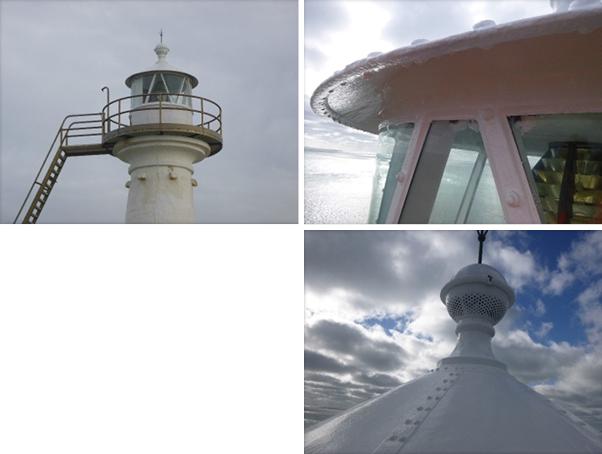 (© AMSA)
(© AMSA)
Description and condition
Conical roof of copper sheets lapped and bolted. Built with single skin (no internal lining). Supported on circular ring of cast iron segments bolted together.
- Ventilator – ball shaped vent, with circular internal insect mesh.
- Lightning conductor – single spike with trident on top of vent.
- Gutter – none.
| Finish | painted |
| Condition | intact and sound |
| Significance | high |
| Integrity | high |
| Maintenance | keep in service, prepare and repaint at normal intervals |
| Rectification works | none |
Heritage significance: High
The lantern roof forms part of a lighthouse, which was integral to South Australia’s growth of navigational assistance during the early twentieth century (criterion a).
The lantern roof forms part of one of South Australia’s earliest unattended lighthouses (criterion f).
Lighthouse feature: Lantern glazing
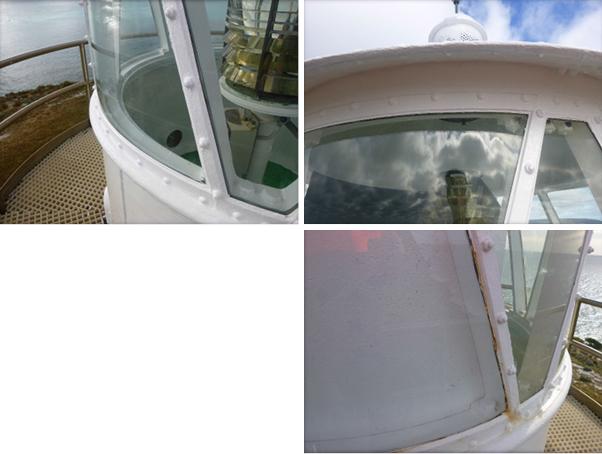 (© AMSA)
(© AMSA)
Description and condition
Cylindrical in form.
- Panes – curved, trapezoidal glass panes, single tier. Landward sector masked by sheet of curved material fitted inside the astragals.
- Astragals – cast iron, bolted to roof support ring at top and to lantern base at bottom.
| Finish | glass: clear other parts: painted |
| Condition | intact and sound |
| Significance | high |
| Integrity | high |
| Maintenance | keep in service, reglaze as necessary, prepare and repaint at normal intervals |
| Rectification works | none |
Heritage significance: High
The lantern glazing forms part of a lighthouse, which was integral to South Australia’s growth of navigational assistance during the early twentieth century (criterion a).
The lantern glazing forms part of one of South Australia’s earliest unattended lighthouses (criterion f).
Lighthouse feature: Lantern base
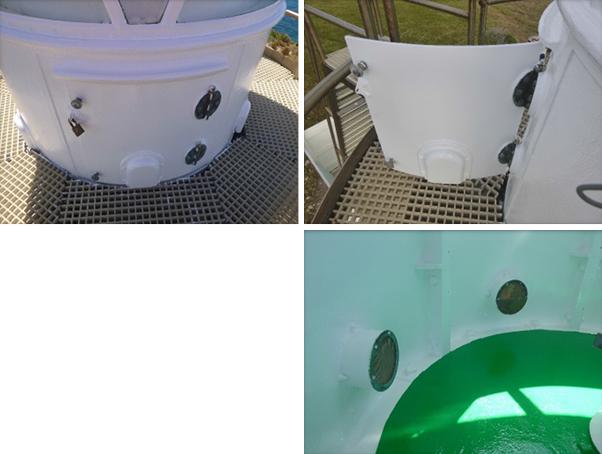 (© AMSA)
(© AMSA)
Description and condition
Chance Bros, cylindrical in form. Curved panels of cast iron bolted together with flanged joints. No internal lining (removed).
- Vents – cast iron cowls outside, one in each panel. Round tube protruding inside from each vent, covered with stainless mesh and half covered with metal plate.
- Door – Replica Chance Bros iron door with copper alloy hinges and thumbscrew fasteners.
| Finish | painted |
| Condition | intact and sound |
| Significance | high |
| Integrity | high |
| Maintenance | keep in service, prepare and repaint at normal intervals |
| Rectification works | none |
Heritage significance: High
The lantern base forms part of a lighthouse, which was integral to South Australia’s growth of navigational assistance during the early twentieth century (criterion a).
The lantern base forms part of one of South Australia’s earliest unattended lighthouses (criterion f).
Lighthouse feature: Lantern floor
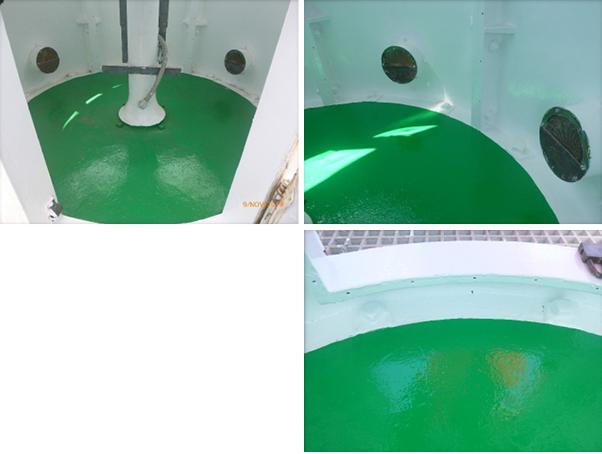 (© AMSA)
(© AMSA)
Description and condition
Concrete slab, continuous with balcony floor and cornice.
| Finish | painted |
| Condition | intact and sound |
| Significance | high |
| Integrity | high |
| Maintenance | keep in service, prepare and repaint at normal intervals |
| Rectification works | none |
Heritage significance: High
The lantern floor forms part of a lighthouse, which was integral to South Australia’s growth of navigational assistance during the early twentieth century (criterion a).
The lantern floor forms part of one of South Australia’s earliest unattended lighthouses (criterion f).
Lighthouse feature: Lens assembly
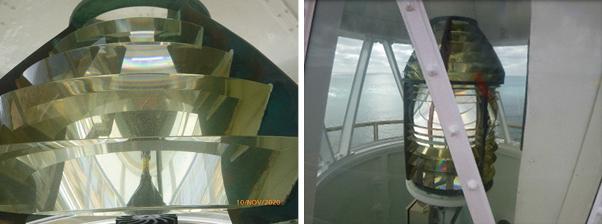 (© AMSA)
(© AMSA)
Description and condition
250mm focal radius fixed (non-rotating) lens assembly of glass and gunmetal.
| Finish | painted |
| Condition | intact and sound |
| Significance | high |
| Integrity | high |
| Maintenance | clean at regular intervals |
| Rectification works | none |
Heritage significance: High
The lens assembly forms part of a lighthouse, which was integral to South Australia’s growth of navigational assistance during the early twentieth century (criterion a).
The lens assembly forms part of one of South Australia’s earliest unattended lighthouses (criterion f).
Lighthouse feature: Light source
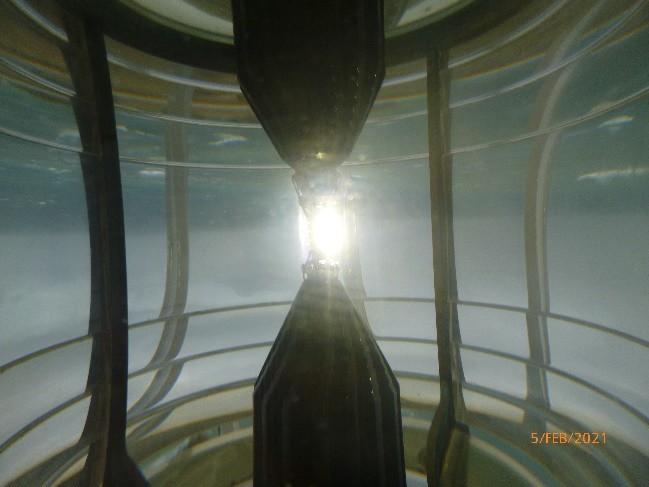 (© AMSA)
(© AMSA)
Description and condition
Sealite SL-LED-216-W.
| Condition | sound |
| Significance | low |
| Integrity | high |
| Maintenance | keep in service |
| Rectification works | none |
The light source is of low significance.
Lighthouse feature: Pedestal
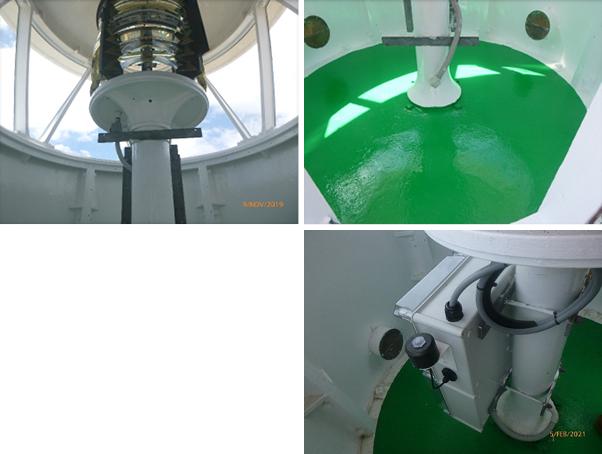 (© AMSA)
(© AMSA)
Description and condition
Cast iron post with fixed circular table on top. Flasher and other control gear mounted in metal box attached to pedestal.
| Finish | painted |
| Condition | intact and sound |
| Significance | pedestal and table: high other parts: low |
| Integrity | high |
| Maintenance | keep in service, prepare and repaint at normal intervals |
| Rectification works | none |
Heritage significance: High
The pedestal forms part of a lighthouse, which was integral to South Australia’s growth of navigational assistance during the early twentieth century (criterion a).
The pedestal forms part of one of South Australia’s earliest unattended lighthouses (criterion f).
Lighthouse feature: Balcony floor
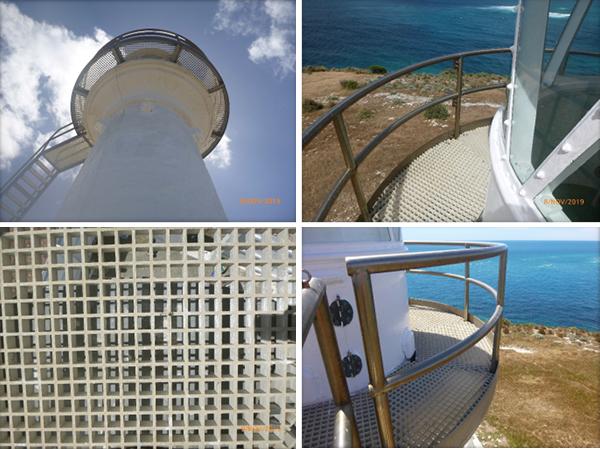 (© AMSA)
(© AMSA)
Description and condition
Recent stainless steel structure with FRP mesh c2006 fixed over 1908 concrete slab, which is continuous with lantern floor and coved cornice and string course.
| Finish | stainless steel: bare metal, FRP coloured mesh membrane painted over concrete slab. |
| Condition | intact and sound |
| Significance | original concrete floor: high stainless steel and FRP: low |
| Integrity | low |
| Maintenance | stainless steel and FRP materials require little maintenance maintain membrane over original balcony slab |
| Rectification works | none |
Heritage significance: High
The concrete component of the balcony floor is an original part of a lighthouse, which was integral to South Australia’s growth of navigational assistance during the early twentieth century (criterion a).
The concrete component of the balcony floor is an original part of one of South Australia’s earliest unattended lighthouses (criterion f).
Lighthouse feature: Balcony balustrade
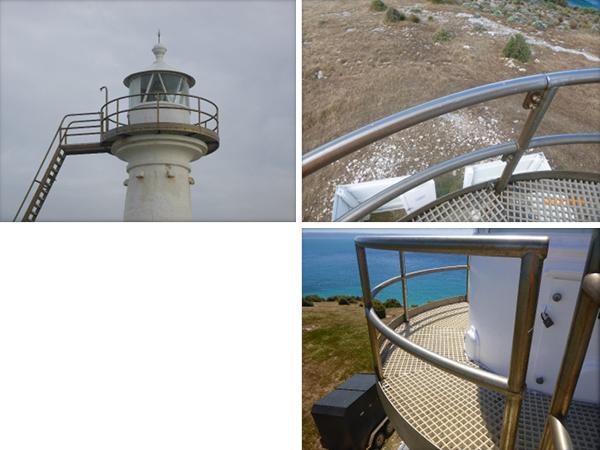 (© AMSA)
(© AMSA)
Description and condition
Stainless steel circular hollow section stanchions, handrails and knee-rails; stainless steel kick-plate.
| Finish | bare metal |
| Condition | intact and sound |
| Significance | low |
| Integrity | low |
| Maintenance | keep in service, monitor condition |
| Rectification works | none |
Heritage significance: Low
The recent stainless steel balustrades are of low significance.
Lighthouse feature: Walls
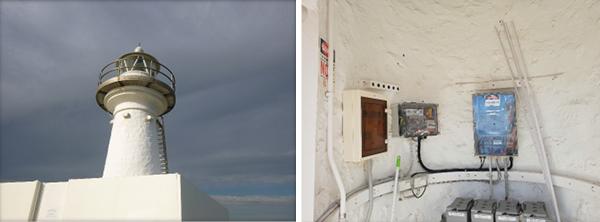 (© AMSA)
(© AMSA)
Description and condition
1908 small conical tower of stone rubble masonry roughly rendered inside and out, with plinth at the bottom. Cast iron vents fitted around the walls, below the cornice.
- Vents – original vents were corroded beyond economical repair. Original covers were replaced with FRP covers, a non-corrosive substitute
| Finish | painted |
| Condition | intact and sound |
| Significance | vent covers: low other features: high |
| Integrity | high |
| Maintenance | keep in service, prepare and repaint at normal intervals |
| Rectification works | none |
Heritage significance: High
The walls are an original part of a lighthouse, which was integral to South Australia’s growth of navigational assistance during the early twentieth century (criterion a).
The walls are an original part of one of South Australia’s earliest unattended lighthouses (criterion f).
Lighthouse feature: External ladder
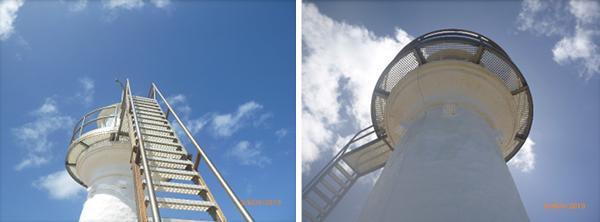 (© AMSA)
(© AMSA)
Description and condition
Fixed ladder from ground to balcony. Stainless steel stiles and FRP treads. Stainless steel brackets fixing the ladder to the ground and to the balcony. (This stainless steel ladder replaces an earlier timber ladder, which was a replacement for the original iron ladder shown on the 1908 drawings.)
| Finish | bare metal |
| Condition | intact and sound |
| Significance | low |
| Integrity | low |
| Maintenance | keep in service, monitor condition |
| Rectification works | none |
Heritage significance: Low
The recent stainless steel external ladder is of low significance.
Lighthouse feature: Door
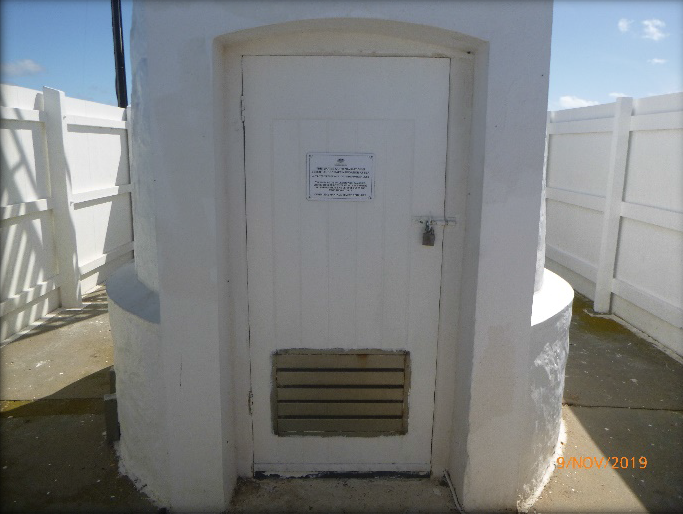 (© AMSA)
(© AMSA)
Description and condition
Early timber framed and sheeted door hung in timber frame on butt hinges. Recent stainless steel louvre vent panel fitted between mid-rail and bottom rail. Secured with pad bolt and CLS padlock.
| Finish | louvres: bare stainless steel other parts: unpainted |
| Condition | intact and sound |
| Significance | door: high louvre: low |
| Integrity | high |
| Maintenance | keep in service, prepare and repaint at normal intervals |
| Rectification works | none |
Heritage significance: High
The door forms part of a lighthouse, which was integral to South Australia’s growth of navigational assistance during the early twentieth century (criterion a).
The door forms part of one of South Australia’s earliest unattended lighthouses (criterion f).
Lighthouse feature: Ground floor
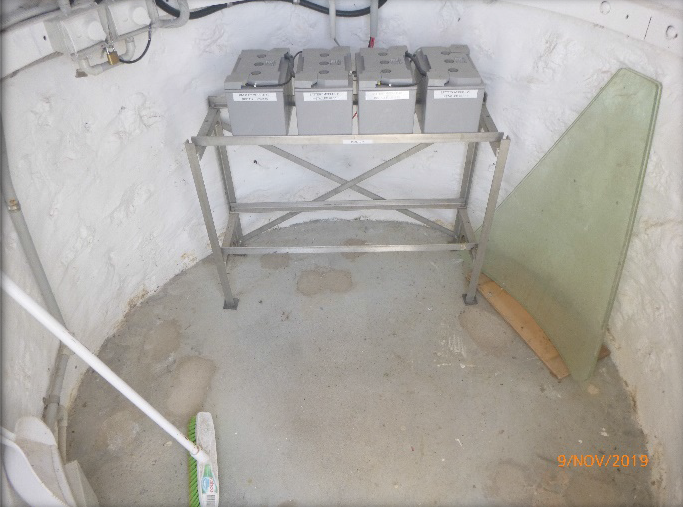 (© AMSA)
(© AMSA)
Description and condition
Concrete slab on ground.
| Finish | painted |
| Condition | intact and sound |
| Significance | high |
| Integrity | high |
| Maintenance | prepare and repaint at normal intervals |
| Rectification works | none |
Heritage significance: High
The ground floor is an original part of a lighthouse, which was integral to South Australia’s growth of navigational assistance during the early twentieth century (criterion a).
The ground floor is an original part of one of South Australia’s earliest unattended lighthouses (criterion f).
Lighthouse feature: Equipment
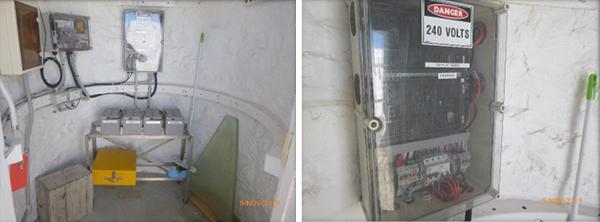 (© AMSA)
(© AMSA)
Description and condition
Equipment installed inside the tower at ground floor level: four batteries on galvanised steel rack; battery charger; cabling; control gear.
| Condition | sound |
| Significance | low |
| Integrity | high |
| Maintenance | none |
| Rectification works | none |
Heritage significance: Low
The equipment is of low significance.
Lighthouse feature: Apron paving
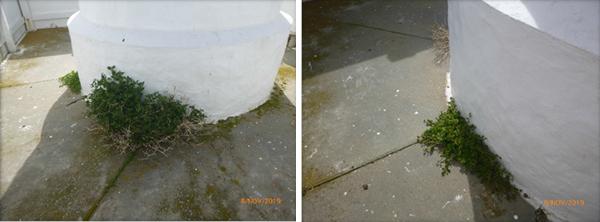 (© AMSA)
(© AMSA)
Description and condition
Concrete paving around the base of the tower, to the full extent of the fenced area.
| Finish | bare concrete |
| Condition | intact and sound |
| Significance | moderate |
| Integrity | high |
| Maintenance | keep in service, carry out minor repairs as required |
| Rectification works | none |
Heritage significance: Moderate
The modified paving forms part of a lighthouse, which was integral to South Australia’s growth of navigational assistance during the early twentieth century (criterion a).
The modified paving forms part of one of South Australia’s earliest unattended lighthouses (criterion f).
Lighthouse feature: Fence
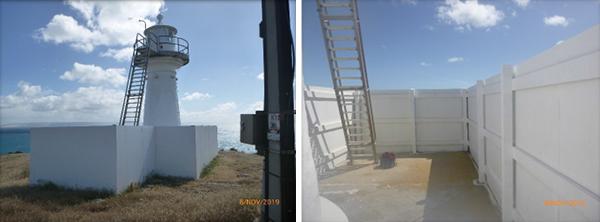 (© AMSA)
(© AMSA)
Description and condition
1908 timber framed fence, extensively rebuilt. Several original posts remain, with evidence of the original arris-cut rails housed into the posts. Most of the posts and all of the rails, are later replacements. The original corrugated iron sheeting was replaced with a ‘super six’ corrugated asbestos-cement. The corrugated asbestos–cement sheet has recently been replaced with a fibre-cement flat sheeting. Timber-framed gate, sheeted with fibre-cement sheet. Storm damaged section of fence on north western side completely replaced in 2016.
| Finish | painted |
| Condition | intact and sound |
| Significance | moderate |
| Integrity | low |
| Maintenance | keep in service, prepare and repaint at normal intervals |
| Rectification works | none |
Heritage significance: Moderate
The modified fence forms part of a lighthouse, which was integral to South Australia’s growth of navigational assistance during the early twentieth century (criterion a).
The modified fence forms part of one of South Australia’s earliest unattended lighthouses (criterion f).
4.2 Related object and associated AMSA artefacts
There are currently no AMSA artefacts stored at Cape St Albans Lighthouse.
4.3 Comparative analysis
Cape St Albans Lighthouse was one of three unattended lights built along the South Australian coast at the turn of the twentieth century. The other two were the Eastern Shoal Light in Spencer Gulf in 1902, and Cape Donnington Light in 1905. The three lighthouses varied in design, but were fitted with similar technologies in order to allow for automatic operation.33
Footnotes
33 ‘Cape St. Albans Lighthouse’, Lighthouses of Australia Inc.